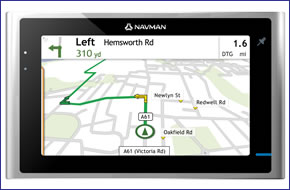Free maps for Navman S-series sat navs. Navman will throw next year's maps for free, for anyone in the UK buying one of its current S-series GPS units. (such as TechRadar favourites the S30.
Design
As revealed at the Sydney Motor Show, Navman has replaced most of its portable GPS line-up with the S-Series. The first change you'll notice is the thoroughly modernised design of the new range. The cheap plastic and physical buttons of yore have been dumped, with multi-toned silver, grey and piano black plastic, as well as rounded sides, taking their place. All four models in the series share the same look -- indeed they're almost identical, except for the S30 which, being the entry level model, makes do with a 3.5-inch touchscreen, not the 4.3-inch of the other models.
Functions, like zooming in and out, which on previous generations were accessed via buttons now reside in on-screen 'soft' buttons on the main map. This layout is not dissimilar to that seen on Mio's GPSes -- this, we think, isn't a mere co-incidence as both Mio and Navman are now owned by the same parent company -- although the Navman's buttons are larger.
Gps Maps Free Download
Typically when we use a GPS in our car, we have it hooked via the cigarette charger. However, using the S30 in this way was difficult -- at least with our test unit -- due to its diabolical USB charger design. To have the S30 charging whilst mounted on the windscreen, the mini-USB plug first needs to be slid into the windshield mount before slipping the S30 into its mount. Attaching the S30 to the mount requires aligning both the mini-USB plug and mount, which is a procedure with more jiggling than a high school formal. Otherwise, the windscreen mount design is compact and neat with a levered suction cup and ball swivel providing for screen adjustment possibilities.
Features
Being the cheapest model in the Navman range, there's not very much to speak about features-wise on the S30. You'll have to splash out another AU$100 to find useful features like Bluetooth hands-free and text-to-speech, which allows generic instructions, such as 'turn left in 100m', to be replaced by more informative ones like 'turn left onto Princes Highway in 100m'.
Google Maps Free Download

The S30 comes pre-loaded with the latest R14 maps from Sensis, although there is an SD-card slot should you decide to purchase maps for use overseas. There are also point-of-interest (POI) markers for all manner of things, from petrol stations and scenic lookouts to speed and red light cameras. Out of the box, most of these POIs are displayed on the map screen which, especially on main roads and suburban centres, makes it hard to see both street details and the suggested route. Another setting we had to tweak was the toll road warning which, by default, displays a large full-screen dialog box whenever a toll road is encountered on route recalculation -- not inherently a bad thing when keying in your destination, but highly annoying when you're pottering along.
Best Cars
Speed and red-light camera locations are marked in yellow and red, respectively, with speed limit signs for the former displayed prominently in the bottom left-hand corner. Although we had audible warnings enabled for safety cameras, they didn't work until we had switched to and from the in-store 'demonstration mode'. Even then, the chime would only sound randomly and often when we had just passed them, despite the fact that we had set the warning distance to be a kilometre.
Performance
We liked the S30's simple to use menus with its array of, now seemingly standard, large buttons. Although we wish manufacturers would get around to having a single soft button which jumps us back to the map, no matter how deep into the menus we are.
In terms guiding us from point A to point B, the S30 did a good, if not outstanding, job. Although we never expect optimal routes with GPS units, the S30 did occasionally suggest a few crazy detours when it would've been much easier to go straight. Route calculation was class average, but we're surprised that it wouldn't start calculating a route until it had satellite lock, which can sometimes take up to five minutes. As is common with portable GPS devices CBD performance, amongst the skyscrapers, was prone to frequent satellite dropouts.
All in all, the S30 is a good-looking entry-level personal navigator. And while the flaws -- the integration of the USB charger with the windscreen mount chief amongst them -- aren't deal breakers, we'd suggest seeing if your budget stretches to AU$500.
Top News
- Cannabis Sativa Monograph Pdf To Excel
- Prolific Usb Serial Driver
- Adobe Photoshop Cs6 Extended Keygen Скачать
- Boston Acoustics Avp7 Manual Muscle
- Comcast X1 Remote Codes For Vizio Tv
- Eyetv Mac Download
- Adobe Acrobat 9 Pro Edit Pdf File
- Eagles Long Road Out Of Eden Rar File
- Mr Chris Hip Hop Dance Moves Download Main
- Dancehall Riddim Download Mp3
- Install Exfat Windows Xp
- Agfa Ap1100 Photo Printer Windows 7 Driver
- Torrent Horse Racing Manager 2 Friv
- Oil Derrick Tekkit Hack Client
- Canadian Foundation Engineering Manual 2006 Pdf Reader
- Dual Boxing Programs L2p
- Prolific Usb Serial Driver Mac
- Id2q Crack
- Security Software For Linux Mint
- Bach Hamburger Sonata Pdf Merge
- Avid Pro Limiter Download Music
- Epicure Software Download